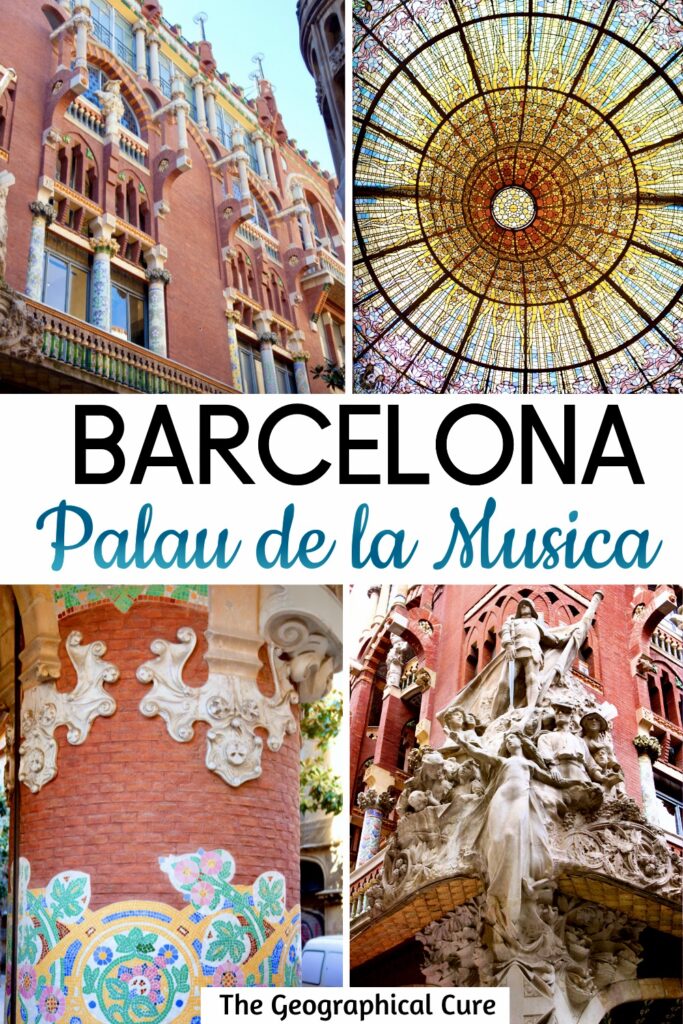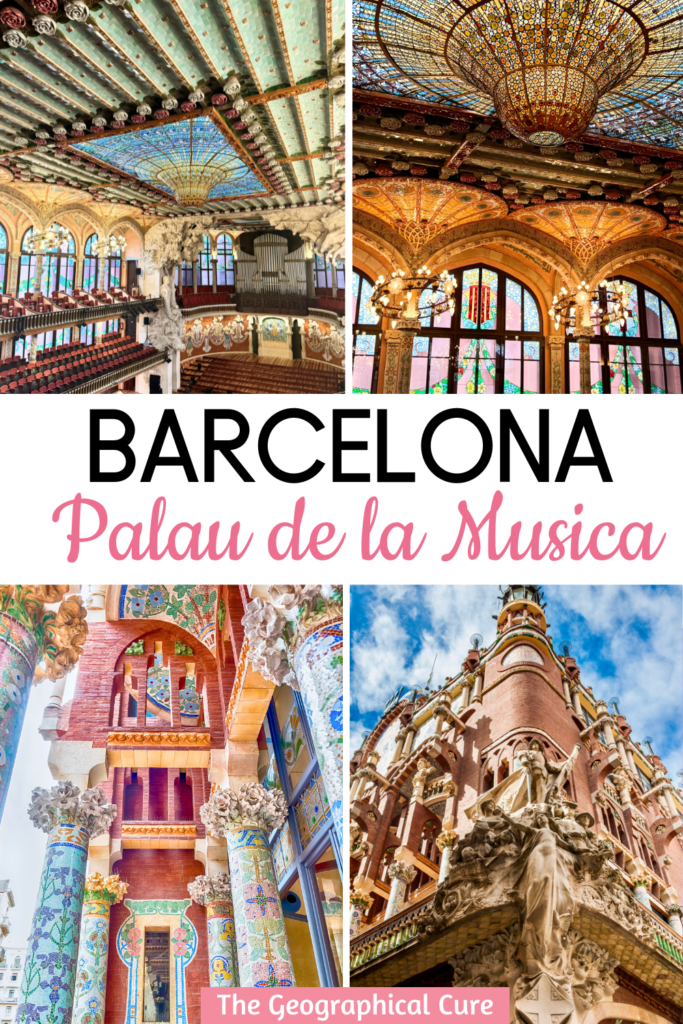Palau de la Musica Catalana is one of Barcelona’s most beautiful spaces. In fact, it’s my favorite Modernist interior in the city.
The palace is full of visual mischief and whimsy both inside and out. The dense ornamentation — glossy mosaics, stained glass, kaleidoscopic skylight, and sculptures — will take your breath away.
The over-the-top nature of the palace was meant to reflect regional Catalan pride. It puts you on notice that, in Catalonia, musicians and composers are akin to the divine.
The gorgeous facade is inexplicably squished into a tiny lane in the Gothic Quarter. You may pass by without even realizing the wonders inside!
The hall itself is stunning and a true work of art swathed in floral motifs. The main concert hall is a masterpiece of light and color, with a one-of-a-kind stained glass skylight.
The hall is variously described as a “crown,” a “music box,” a “garden with no night,” a “box of light,” a “magic fishbowl,” and a “glowworm.” Whew!
In this guide to Palau de la Musica Catalana, I tell you everything to see inside and give you tips for visiting.
Quick Tips:
- you can visit on your own, on a guided tour, or by attending a concert
- I highly recommend pre-booking a skip the line ticket to avoid queues and or a sold venue
- if you are on a guided tour, which I was, you will meet your guide behind the bar on the first level (no signs point you that way)
- tours are 50 minutes and you can stay as long afterward as you like
- tours include a 10 minute introductory video
- the palace is in the Gothic Quarter
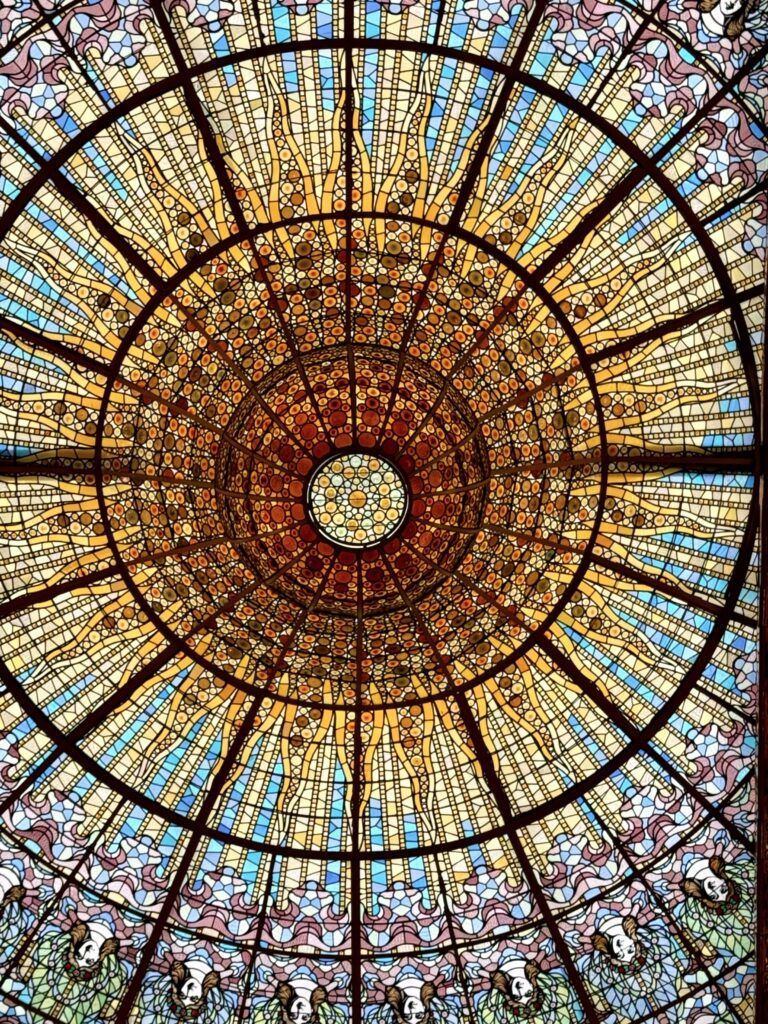
Overview & Mini History Of Palau de la Musica
The palace was designed by Catlan modernist architect LLuis Domenech Monanter. It was built between 1905-08 for the Catalan Choral Society.
The spectacular creation was fueled by the fervant spirit of the Renaixenca, a Catalan cultural revival movment in the late 19th and early 20th centuries.
From its inception, the vision for the palace was much more than just a concert hall. It was intended to be a splashy showcase of Catalan artistry and identity.
The architect, Montaner, was a peer of the seemingly peerless Antoni Gaudi. But you will see straightaway that Gaudi had no monopoly on Modernism. Montaner is vastly underrated by comparison and equally bold in imagination.
Montaner was a Renaissance man — a genius in architecture, fine arts, history, and politics. He studied in Paris and Venice.
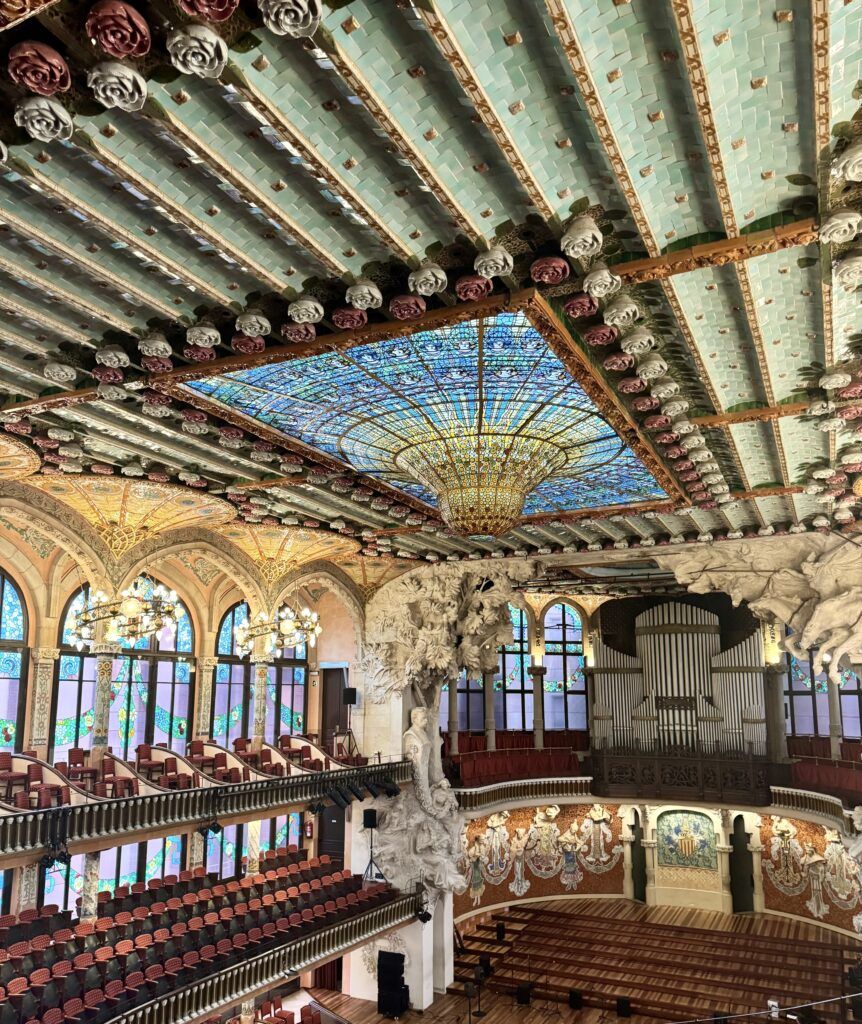
Palau de la Musica is the pinnacle of his great career, combining a Modernist aesthetic with a glam Catalan style.
Right after its debut, the palace won the best architecure award from the city council.
Throughout its history, the Palau has played a central role in Barcelona’s cultural scene. It hosts a diverse array of musical performances, from classical concerts to contemporary works.
It’s also served as a gathering place for social and political events, embodying the spirit of Catalan pride and resilience.
In 1997, it became a designated UNESCO World Heritage site.
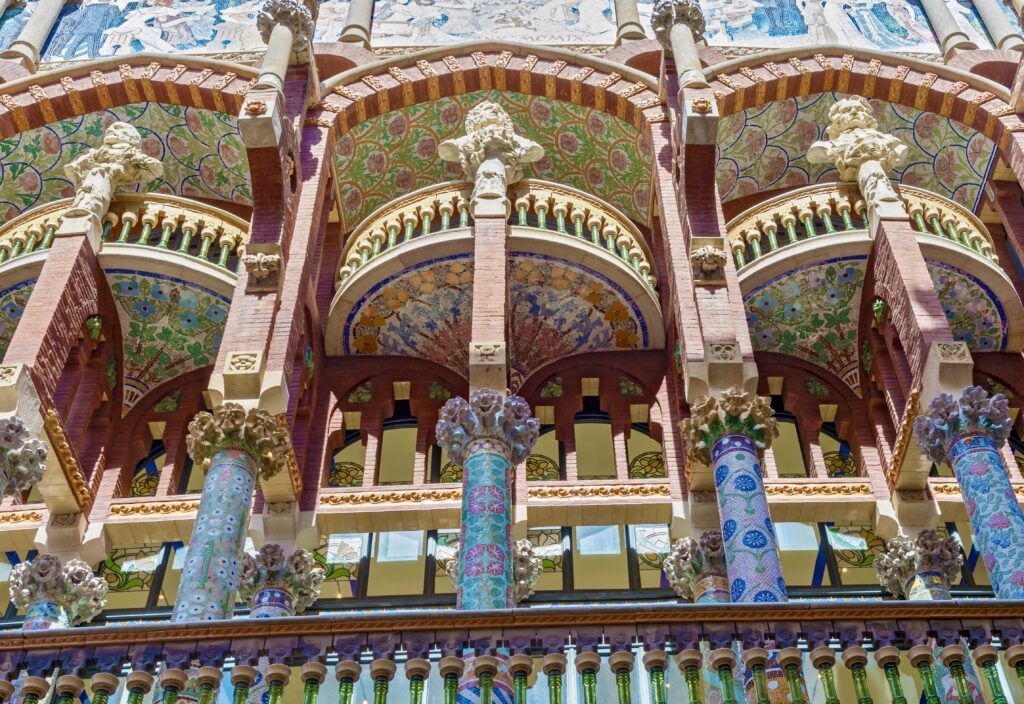
Guide To Palau de la Musica: What To See
Here are the highlights of a visit:
Facade
The rather gaudy facade is extremely unusual. Rather than being an enclosure, it is open on all sides with few continuous walls.
It is a harmonious marraige of iron, brick, glazed tiles, and glass. All that is supported by an iron frame, which was the first curtain wall building in Spain.
The facade has layers of decoration.
On the ground level are mosaic encrusted arched columns and windows made of pastel colros and floral shapes. Above that are 14 Corinthian columns in different mosaic patterns.
Higher still are brick columns topped with busts of Palestrina, Bach, Beethoven, and Wagner. Even higher is mosaic mural depicting a choir presided over by a queen.
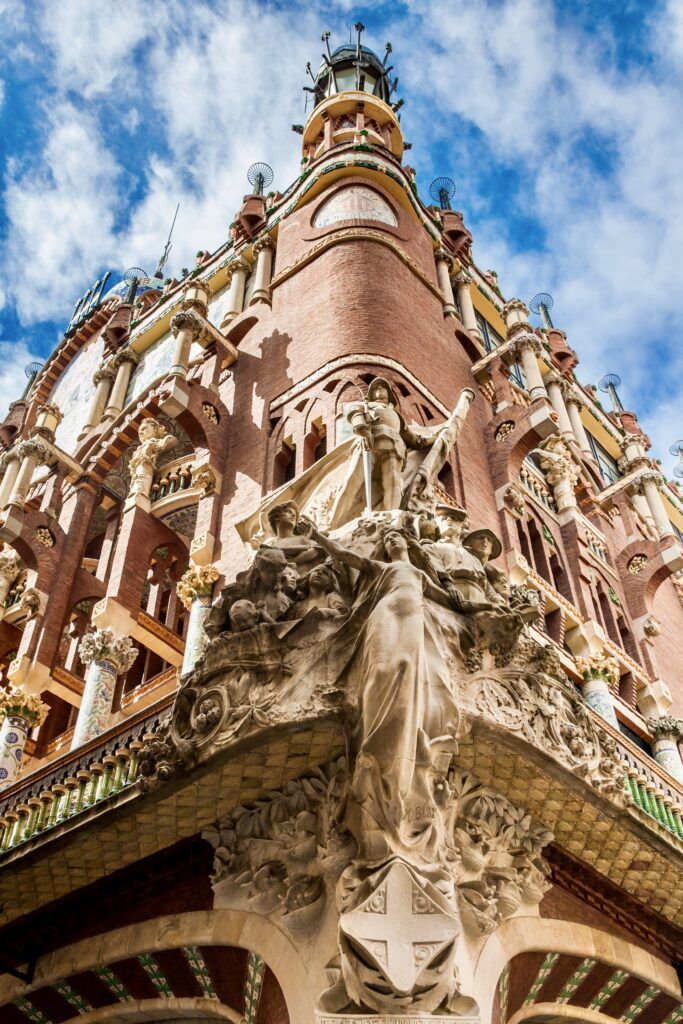
At the corner of the facade, at the intersection of Carrer d’Amadeu Vives and Carrer de Sant Pere Més Alt, is a massive stone sculpture by Miquel Blay, The Popular Song, from 1909. It practically bulges from the corner.
The allegorical sculpture portrays a song maiden, with outspread arms, surrounded by encouraging Catalans.
Above, a helmeted soldier (St. George, Barcelona’s patron saint) extends a protective gesture with an unsheathed sword.
The roofline has Moorish touches. And the roof itself is crowned with some colorful ceramic chimneys.
A revamped entryway with a glass facade now welcomes visitors into Palau Square. This transparent wall was a creation of architect Òscar Tusquets.
It gives you a clear view into the building’s interior, merging modern architectural innovations with the Palau’s historic charm.
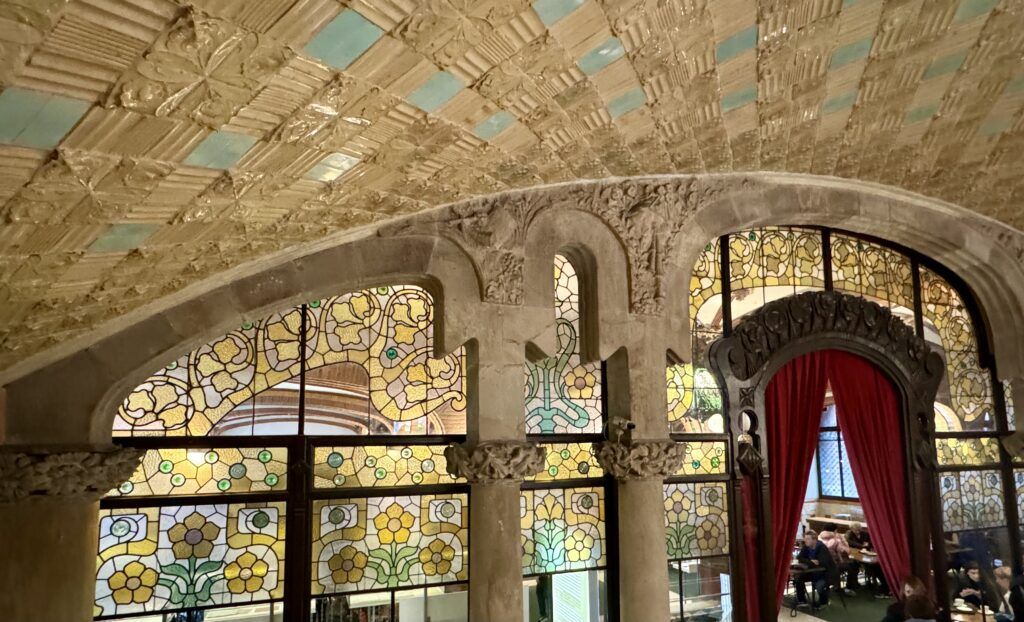
Vestibule & Foyer
Once inside, you’ll see that the interior is even more extraordinary than the exterior.
The lobby is a warm rush of color. The Gothic-inspired ceiling is decorated with glazed ceramic tiles forming star shaped patterns.
There are twinkling lanterns and chandliers, blond marble, and stained glass with floral motifs. On each side are grand marble staircases weaving up to the next level.
They’re very ornate, decorated with transclucent yellow balusters and intricate carved reliefs. The column-like balusters have a ginger-colored ceramic base and are topped with a crown of roses.
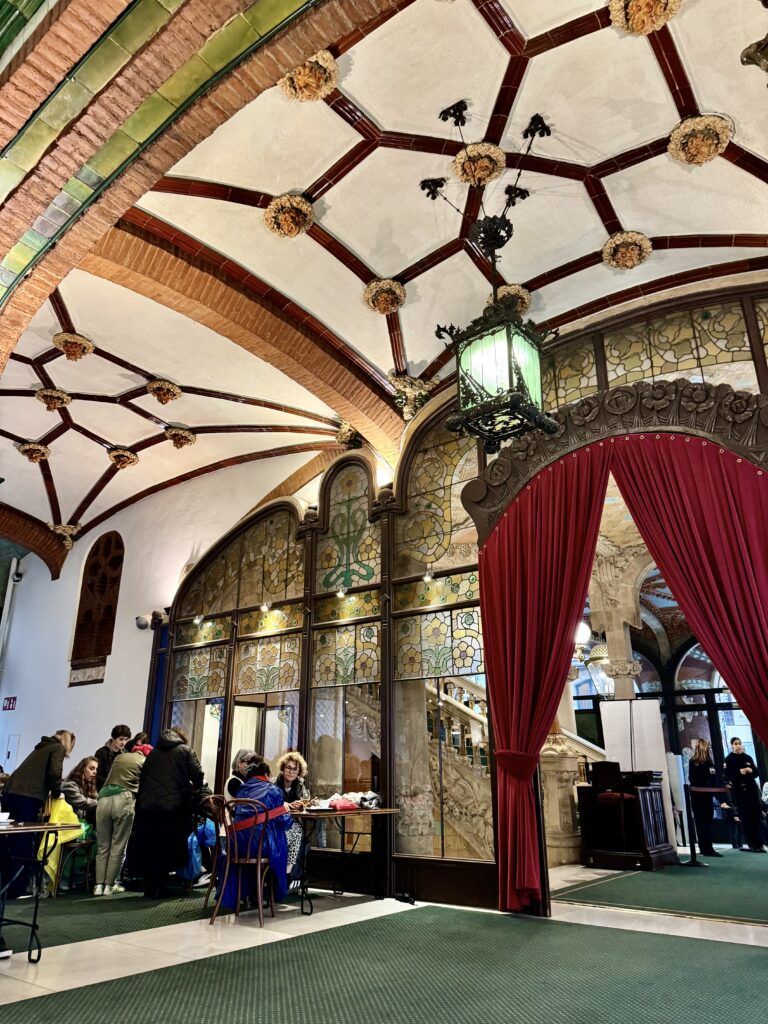
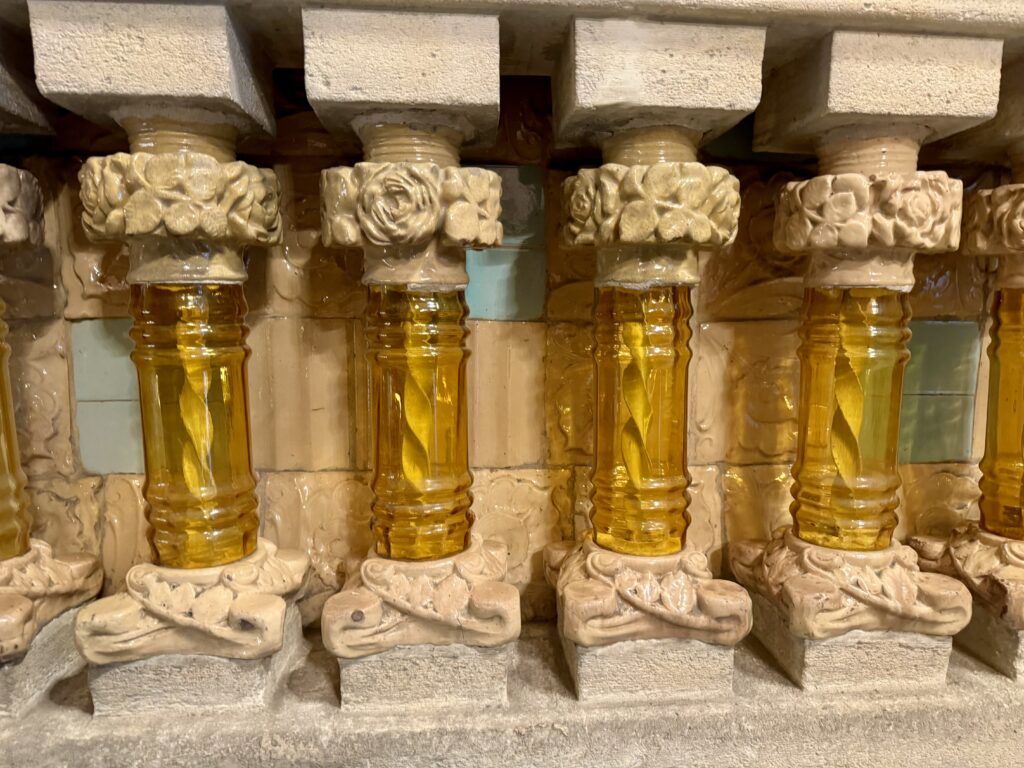
Head straight through the brick arches and you’ll enter the knockout bar and cafe.
The arches are decorated with green tiles and the capitals are encrusted with roses. There is an ornate ceiling with green ceramic ribbing and and green and gold stained glass.
The bar itself is resplendent, surrounded by stained glass panels in the shape of blooming flowers.
Rehearsal Room
If you are on a guided tour, this is where your visit starts. The palace is the home of one of the world’s leading choirs and this is where they rehearse.
You can see the first stone laid for the building and musical notes built into the tile floor.
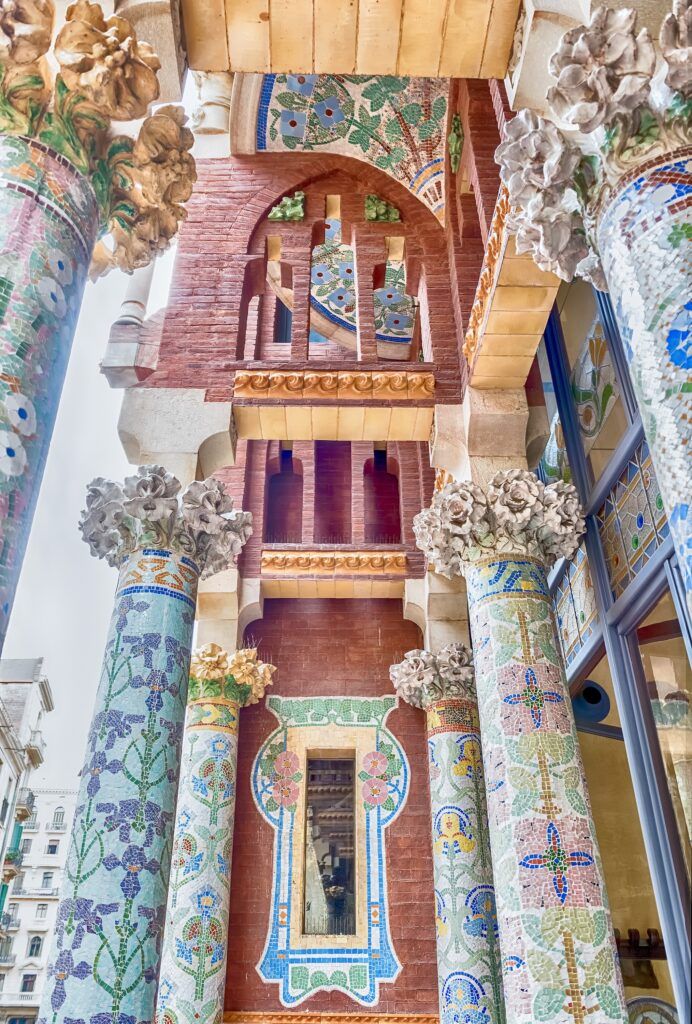
Louis Millet Lounge
On the first floor there is a two story high lounge named after Louis Millet. This is where concert goers can arrange to meet or take a break.
There are beautiful stained glass windows and busts of personalities connected to the palace.
Through the windows, you can glimpse the double colonnade of mosaicked columns on the facade. The effect is like a magical garden.
These columns are a favorite spot of Instrgrammers. To inspect them close up, you’ll have to line up on the right side of the lounge to walk across the terrace.
Every column has different colors and floral decorations.
Main Stage & Auditorium
The auditorium is called the Sala de Concerts. It seats about 2,000 people.
The ornamentation here is so dense that you almost don’t know where to look!
You might not even be sure what it is. Is it a theater, a beautiful chapel, or a fancy salon? From the decoration and scuptures, it’s unclear.
What is clear is that it’s utterly unique. It’s like a glass case full of jewels and trinkets.
The seating swirls around all three sides. The setting is intimate, as if every seat were near the stage.
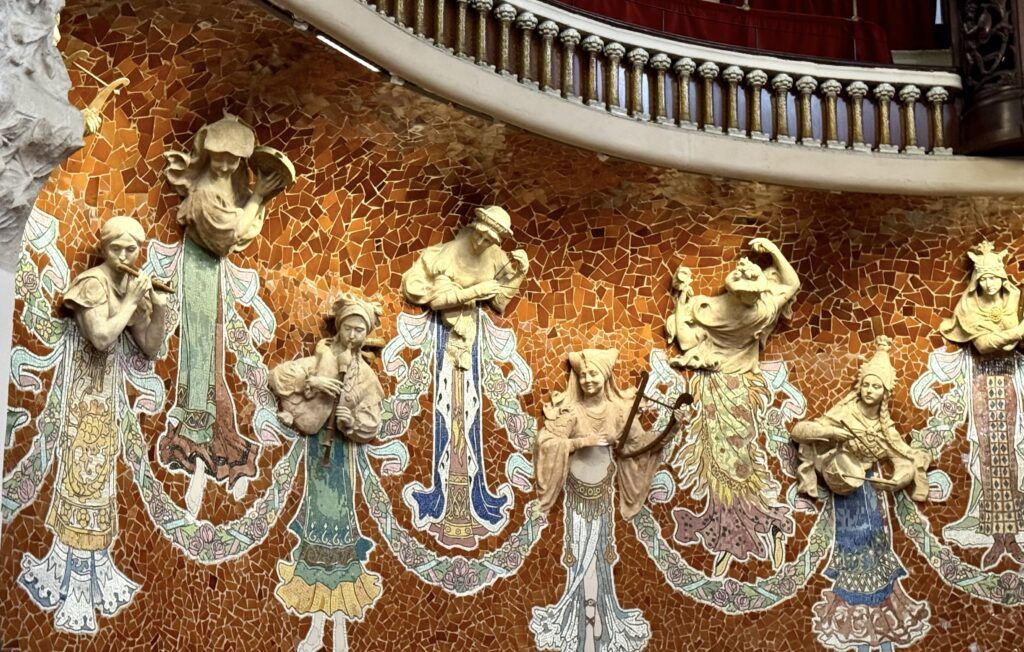
The stage features an elaborate sculptural backdrop, which includes 18 muses and floral motifs. Full of vivacious charm, the muses are like sirens with an unconventional presentation.
They have solid sculptural upper halves that stand out from the wall. But their skirts are filled in with mosaics in soft underwater hues.
When unveiled, they weren’t terribly popular. But now they are beloved.
Flanking the stage are two massive stained glass panels, which add to the vibrant color scheme of the interior and portray various musical and natural themes.
Fun Fact: Apparently, while beautiful, the stained glass contributes to the poor acoustics of the concert hall.
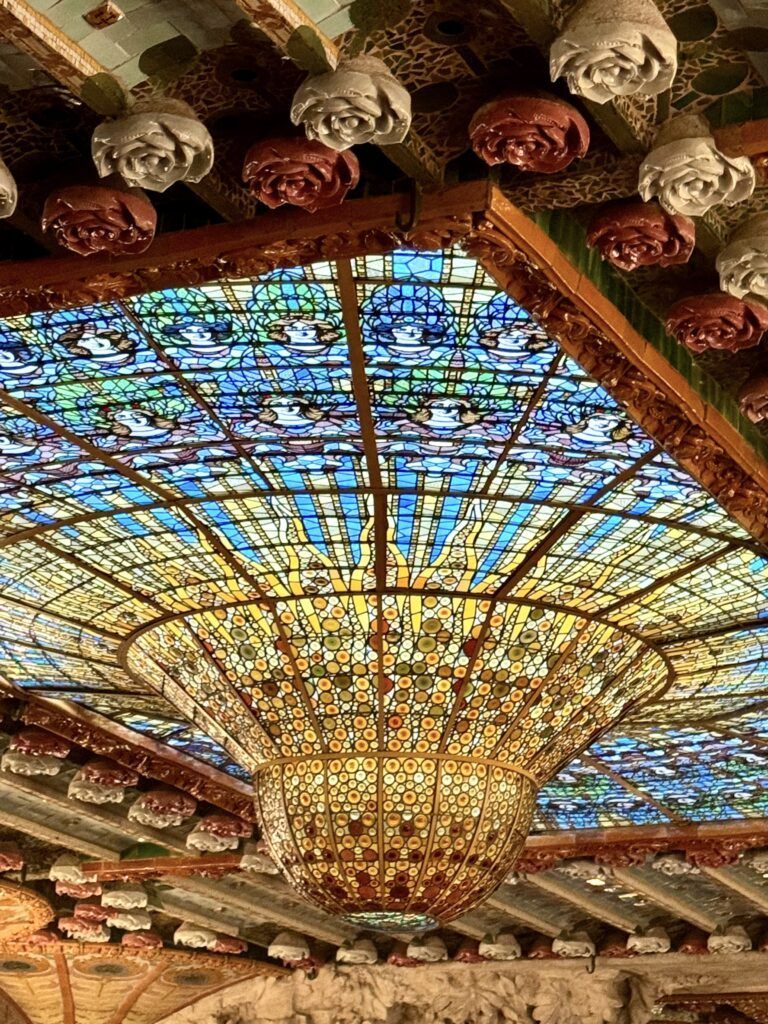
Skylight
The absolute highlight is the massive rectangular skylight of exuberant color. It was designed by Antoni Rigault, a Modernist painter and stained glass artist.
In the center is a massive luminous drop, a sort of inverted dome. It looks like a sunburst, with sunlight spilling down onto the audience.
The rest of the skylight is a serene blue, a lake of sorts.
On the lake float a series of women or sea sprites, the proverbial ladies of the lake. They are a counterpart to the muses on stage playing musical instruments.
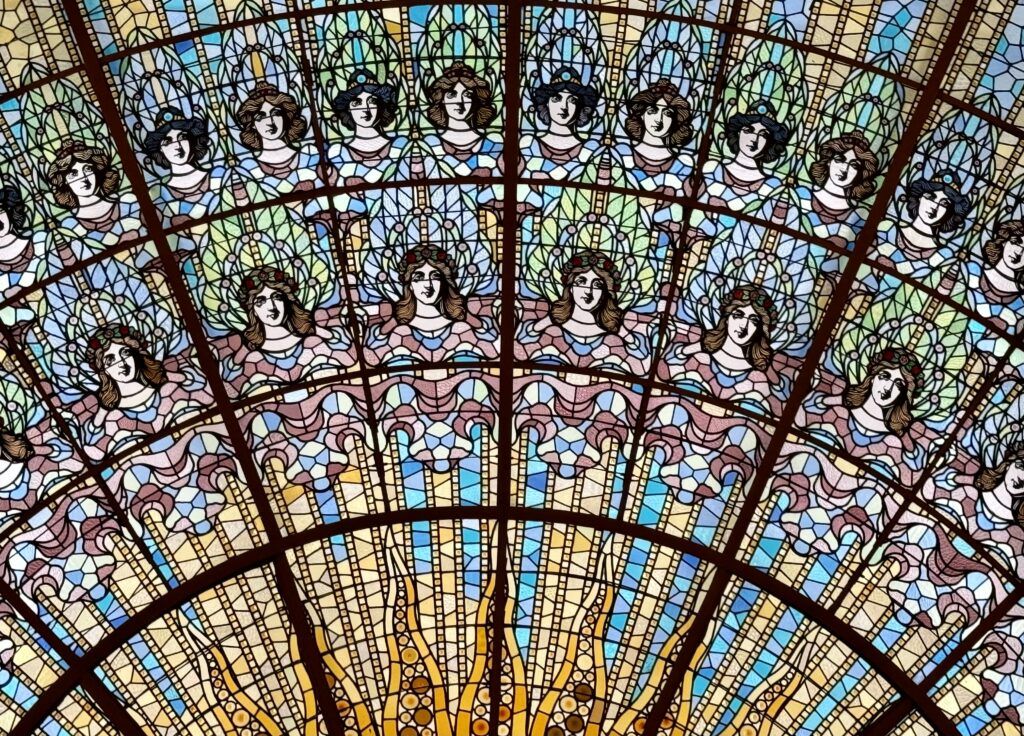
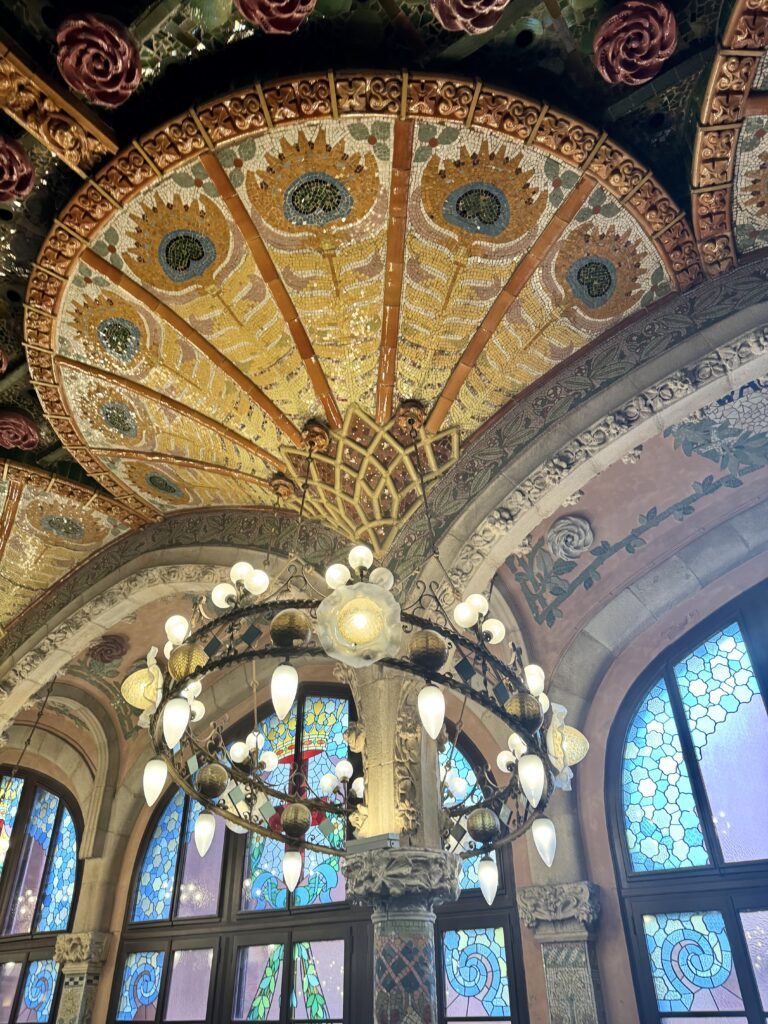
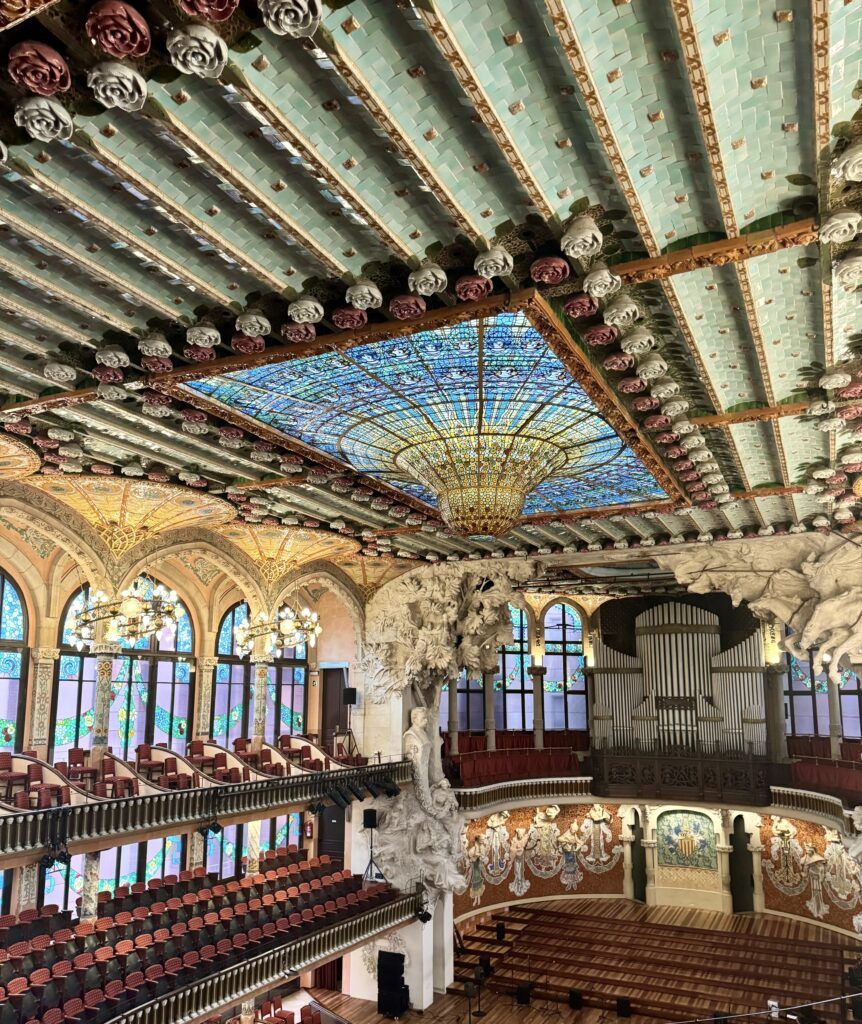
Those closest to the sun are fair. Those further away are darker.
The skylight is bordered by ceramic roses and sheets of light green ceramic glass.
On the sides, it’s framed by semi-circular fan-like structures. Their ceramic decorations appear like feathers or a sunflower stalk.
Below the fan shapes hang iron chandeliers with different kinds of light bulbs. They’re tilted in a way that makes them look like the head of a sunflower.
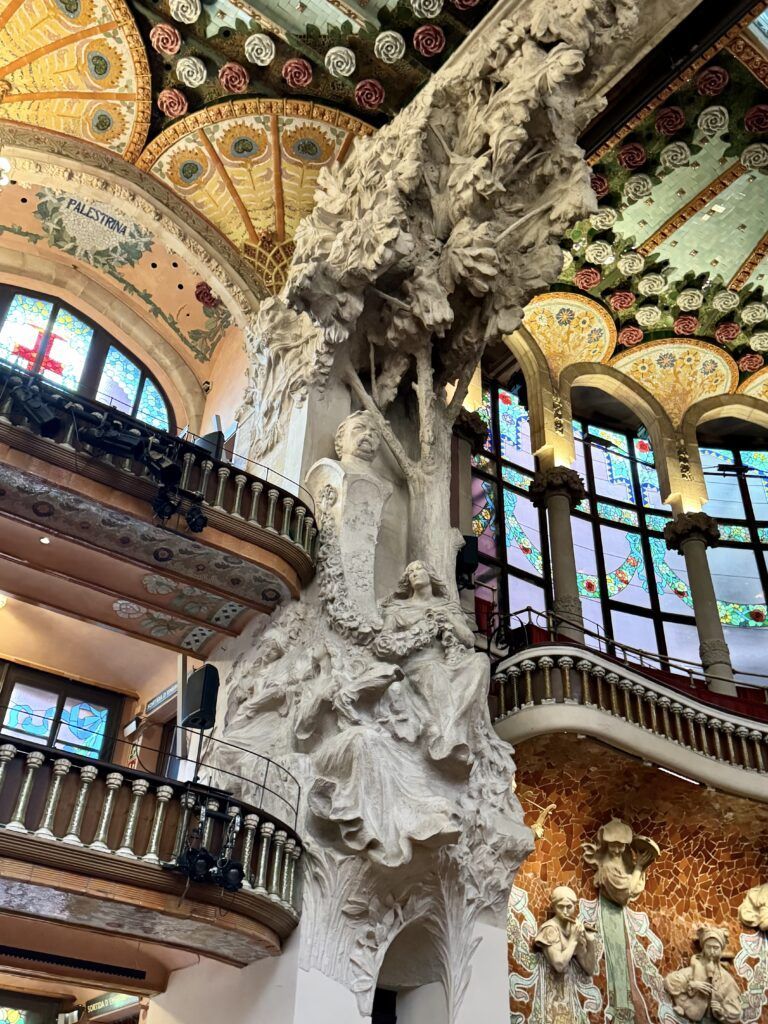
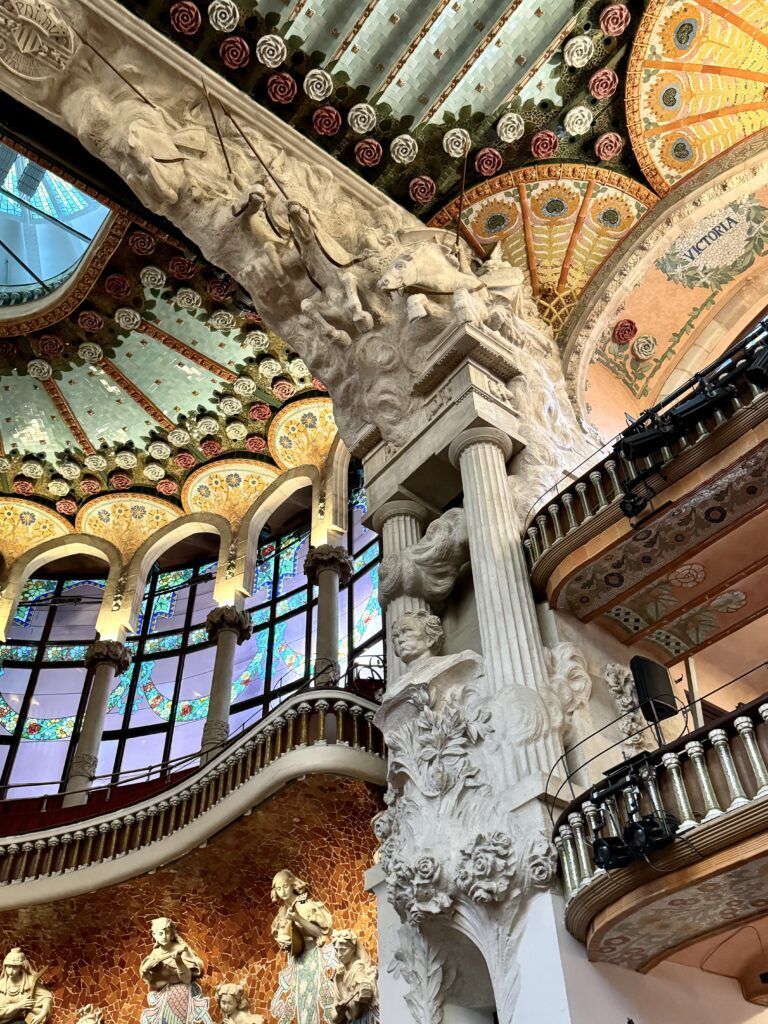
Sculptures
The concert hall is full of beautiful sculptures. I mentioned the celestial choir or women. But there is plenty else to admire.
To the left of the stage is a sculpture of Joseph Clave. Clave, with his famous choirs and folk songs, epitomes the choral style with which the palace is associated.
Beneath Clave’s pedestal are several young women singing The Flowers of May.
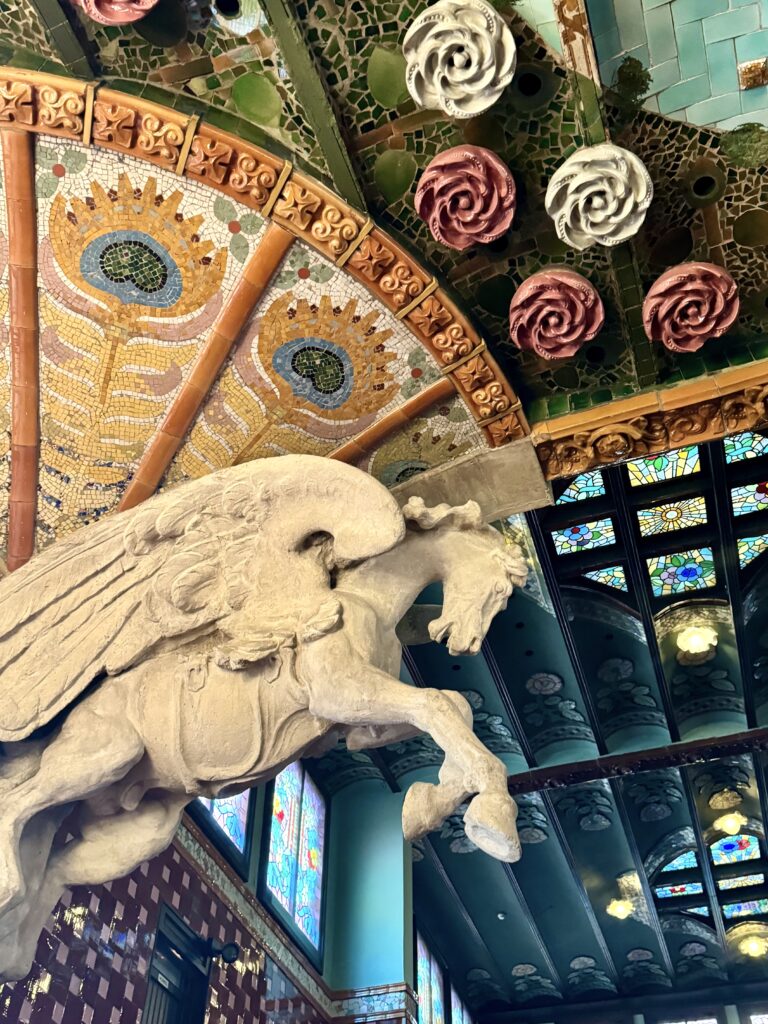
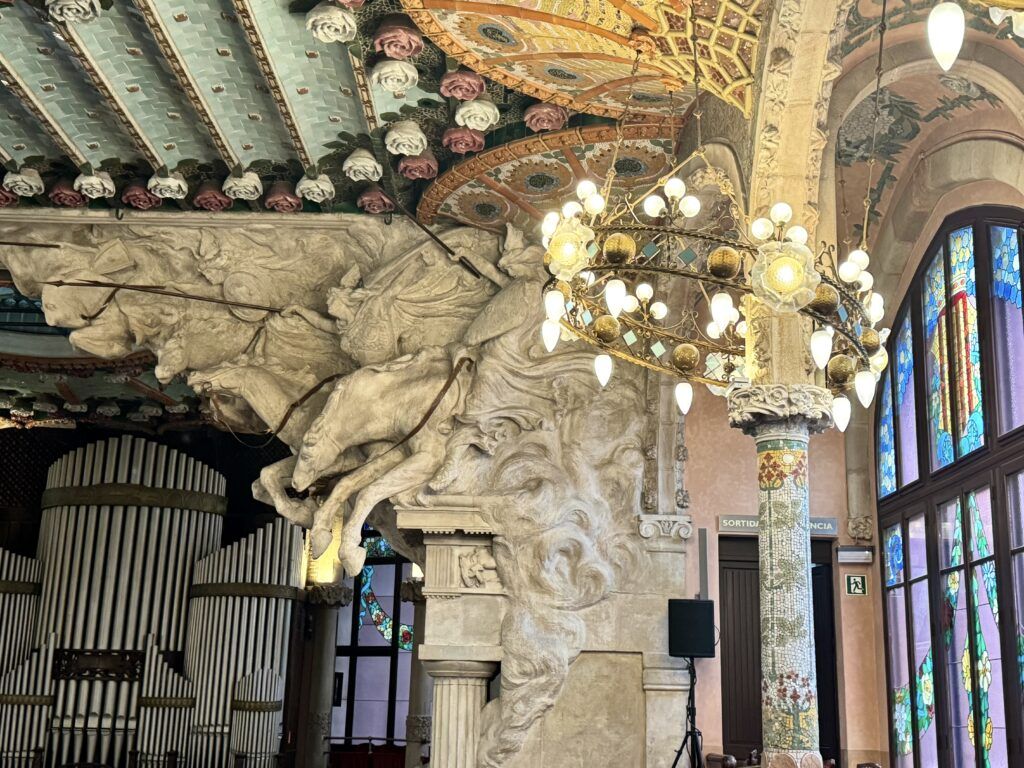
On the right side of the stage, you see a bust of Beethoven, an ode to classical music. He has his usual unruly hair and grouchy look.
He’s topped by Valkyries riding horses, a nod to Wagner’s opera Die Walküre.
Aside from these sculpture, the other horses on the upper balcony represent Pegasus. According to Greek mythology, the winged horse sprang from the union of Poseidon and Medusa.
Pegasus was ridden by the muses when Zeus called them to sing for him on Mount Olympus.
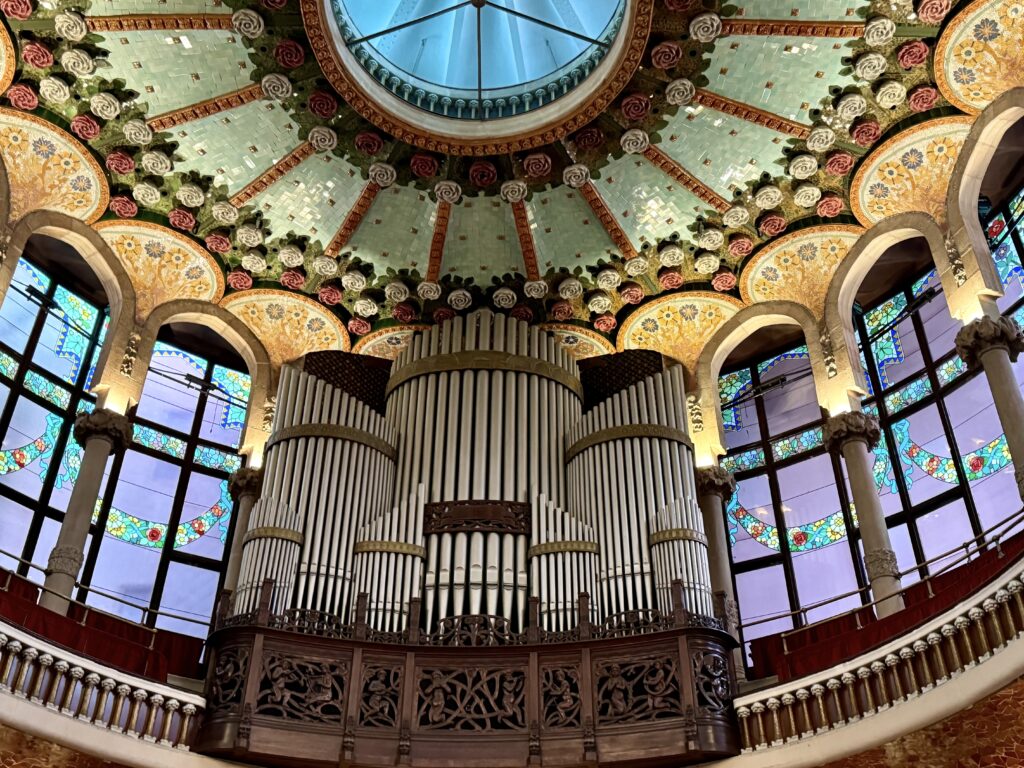
Practical Guide & Tips For Palau de la Musica
Address: Carrer Palau de la Musica, 4-6
Hours: Open daily 9:00 am to 3:30 pm.
Tickets:
18 euros for the basic ticket, 22 for a ticket that includes the audio guide. You can pre-book a skip the line ticket online in advance.
If you want to take the English language tour, I would definitely book that in advance as well. Your guide will even turn on the organ for you!
Pro Tips: There is a small gift shop behind the bar on the first floor. There are free bathrooms downstairs in the basement.
Concerts: The palace hosts about 300 concerts a year of all types of choral and classical music. Click here to check out what’s on.
Is Palau de la Musica Worth Visiting?
100% yes. You may have read that it’s beautiful. But it’s even more stunning that you expect in person.
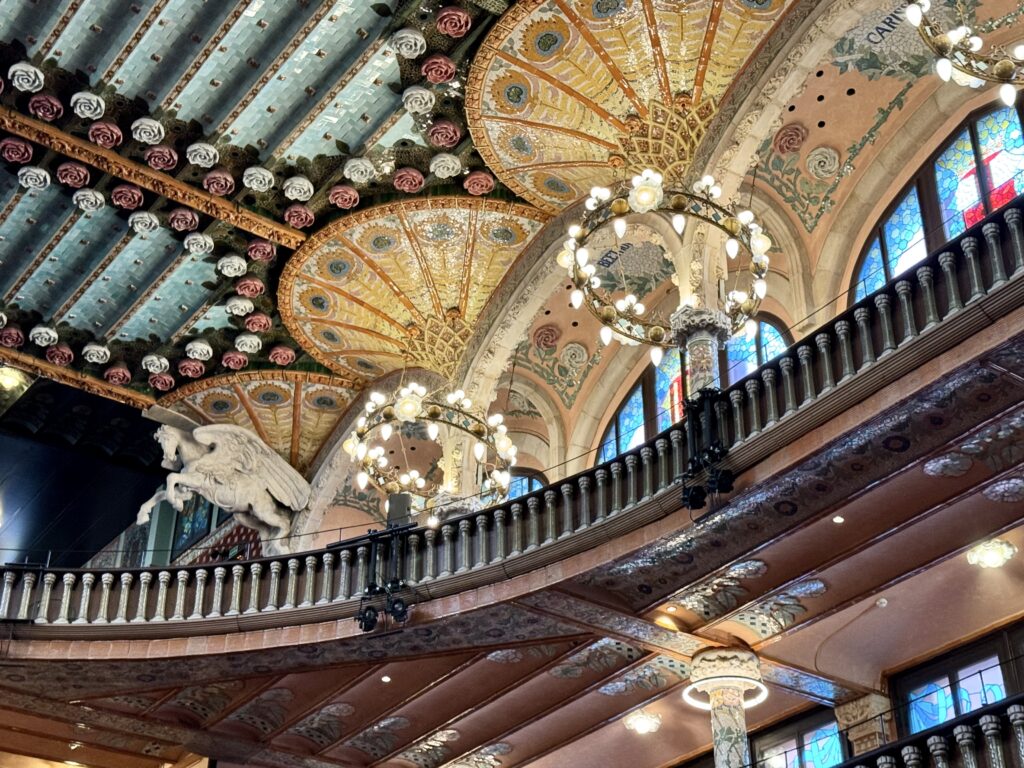
Plus, if you are an architecture buff or love Art Nouveau, this is a splendid chance to see a building by someone other than Antoni Gaudi.
Montaner is less heralded, but still one of the giants of Moderism. You’ll want to see his defining masterpiece.
I hope you’ve enjoyed my guide to Palau de la Musica Catalana. You may find these other Barcelona travel guides useful:
- 1 day in Barcelona itinerary
- 3 days in Barcelona itinerary
- what to do in the Gothic Quarter
- landmarks in Barcelona
- guide to Casa Batllo
- guide to La Pedrera
- guide to Palau Güell
- guide to architecture in Eixample
Pin it for later.

